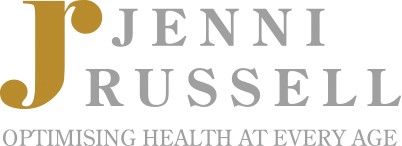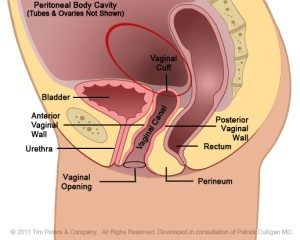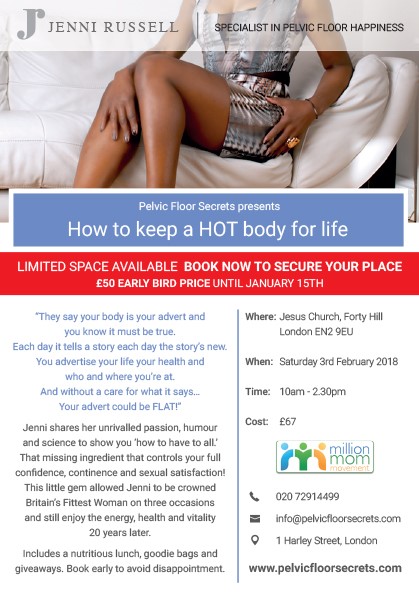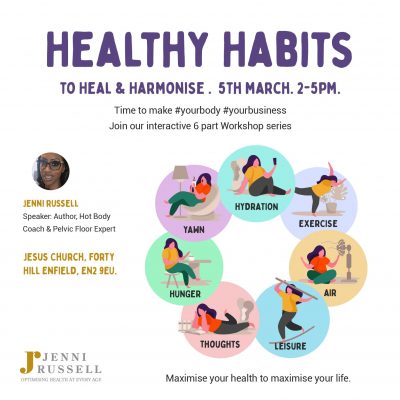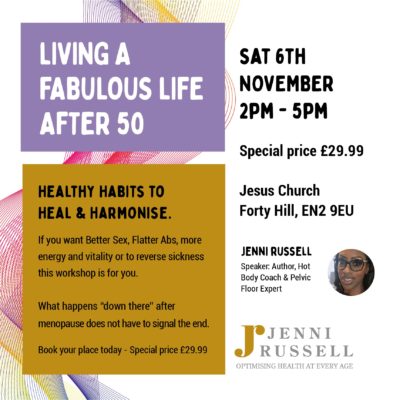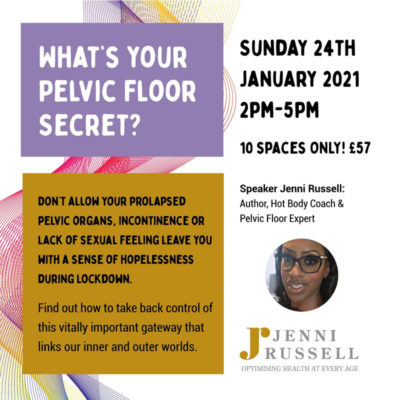BLOG
Jenni Russell’s latest news and information
How to enjoy life after endometrial cancer and hysterectomy
Cancer can never be a sickness that is easy to deal with and for women it is doubly hard when it is within the uterus and a hysterectomy is seen as the way to preserve life. Outwardly it may appear as if life will be hard to enjoy, especially if one has not yet had the family they desire and it can be made worse if they then suffer bladder retention having to self-catheterise. But there is hope for a brighter healthier future with some basic lifestyle adjustments and a little understanding of the role stress plays to inducing or reducing health.
It is a difficult blog to write for such a sensitive subject, that can affect women at any age, but I do hope the information is encouraging and useful.
 I am sure you have heard the statement “stress can kill you.” Whist this may not be true for those reading in the literal sense, it is true in terms of killing our health and vitality. Our body was never designed to live on and with the levels of stress within us today. There are different types of stress that manifest within us. Each of them good when controlled or bad in the excess:
I am sure you have heard the statement “stress can kill you.” Whist this may not be true for those reading in the literal sense, it is true in terms of killing our health and vitality. Our body was never designed to live on and with the levels of stress within us today. There are different types of stress that manifest within us. Each of them good when controlled or bad in the excess:
- Mental Stress
- Physical Stress
- Emotional Stress
- Chemical Stress
- Nutritional Stress
- Electromagnetic Stress
All of these can have a positive and negative impact on health and wellbeing. Cortisol is a stress hormone produced in the adrenal glands in response to the varying levels of stress from the above-mentioned factors. As women, we house much of our emotions in our pelvic and reproductive region also known in oriental medicine as the 2nd chakra. Although the first place stress dumps itself is in the jaw, neck and shoulders. Whilst the psoas – the muscles in the hips, better known as hip flexors respond to our continuously induced stress hormones (they house much of our emotion and pain, with the uterus living in-between) by shortening and tightening. They are known as our fight/flight muscles – getting us ready to either stay and fight or turn and run. As these muscles and our stress hormones elevate, the hormones responsible for repair, restore, rebuild and refresh are suppressed. With all this stock piling of our emotions it is no wonder we may suffer painful periods and issues such as endometriosis.
When the body is in pain or under pressure the first thing that is altered is our breathing. There are two classic reactions to our breathing with pain and discomfort; we either hold the breath or hyperventilate. Holding the breath is usually a fear reaction, which creates increases acidity in the body, throwing our PH balance out of sync, whilst hyperventilating means the diaphragm no longer works through its full range of motion which creates a false sense as if we are dying inside.
The easiest and most vital way to improve our health and wellbeing is to focus on the quality of our breathing. Breath – oxygen is life force energy – the chief and most important energy system in the body. No oxygen no life! The quality and movement of oxygen around and to every cell in our body is dependent on the range and freedom of movement of the diaphragm. The diaphragm is the biggest biological pump in our body which creates the pressure fluctuations within the abdominal cavity. It is these pressure fluctuations that ultimately impact our eliminatory organs and pelvic floor muscles. It also promotes the arterial delivery (oxygen to the cells and organs) and venous return (rate of blood flow back to heart) which is vital to healing since oxygen is truly a nutrient (Paul Chek Totem Pole Page 191 Pelvic Floor Secrets. Listen to my interview with Paul Chek on the Beauty of breathing here).
If the diaphragm does not work well, the abdominal wall will not work well and neither will the pelvic floor muscles. Oxygen brings life force energy to every area of the body it gets to, also bringing the nutrition necessary to rebuild, repair and remove waste. After major surgery to remove both the cancer and uterus, it is vital for healing to optimise breathing so that healing and restoration are optimised and the build-up of scar tissue that naturally occurs after an operation is minimised improving the natural flow and ebb of the body – arterial delivery. All the organs in the body have a natural expansion contraction cycle and the bladder and bowel are no different. Improved diaphragmatic breathing can help stimulate waste and the sphincters control the bladder to avoid retention. What is also clever is that the curved end of a paperclip on the scar can help offset and/or minimise lesions which can inhibit the ureters or bladder neck to promote healing.
The lungs end at the base of the base of the rib-cage. As an asthma sufferer, it is vital to master diaphragmatic breathing. The lungs expand and elevate with every breath in therefore the ribcage needs to expand laterally also we inhale. Try placing your hands on the side of your ribs to feel what happens? It is 2/3rd tummy and 1/3rd chest when we breathe in, with little or no movement of the shoulders. Being able to breathe in for the count of 4 seconds and out for 6, can make a significant difference to the oxygen flow around the body and thus the time needed to heal.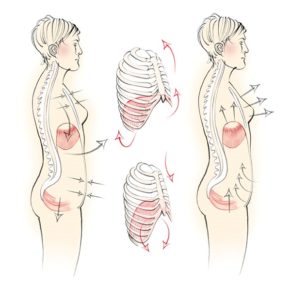
Breathe new life back into your body and couple this with positive thoughts – since nothing can happen good with negative thoughts. You are fearfully and wonderfully made and you remain a blessing.
When breathing is optimal we are in a better position to stimulate the pathway that promotes rest, repair, rebuild, restore, refresh. This pathway known as the parasympathetic pathway, aids digestion and elimination. It is one of two pathways that run the nervous system of the body. The other is the sympathetic nervous system, responsible for what is called our ‘fight/flight’ response. This pathway does the opposite of the aforementioned as its sole responsibility is to keep us alive. It suppresses the repair and sex hormones, by diverting the oxygen away from our digestive and reproductive organs out to the muscles and skin.
The sympathetic pathway is heavily influenced by the stress hormone cortisol which is produced in the adrenal glands. Elevated levels of cortisol also raise the heart rate and blood pressure (and may cause excess sweating), which over the long term is never a good sign especially if it is followed through with a poor-quality diet, lack of sleep and/or other lifestyle deficiencies.
Basically, cortisol is our wakeup hormone. It rises in line with the natural circadian rhythms of the sun and is supposed to lower as the sun lowers. This allows melatonin to rise in line with the evening and moon to prepare our bodies for sleep so we can rest, repair, restore, rebuild and refresh. Unfortunately, our daily lifestyle and the blue rays from our TV’s smartphones and computers means cortisol remains high and melatonin low. Neither cortisol or adrenal were meant to be active long-term hormones of the body. The body has gone through two major stresses – the cancer and then the hysterectomy. Therefore regaining body balance is vital to regaining health and happiness. Optimising your breathing helps activate the repair and restore pathway, where the sympathetic pathway tends to dominate and suppress it. Giving thanks you still have life and opportunities is another way to stimulate health and vitality.
If money were no object, what would your day look like? Focus on what you would do with your time rather than the money.
- Would you continue to work? The same job or something different? What adventurous things would you do or how spontaneous would you be or become? What would you eat? Who would you spend the most time with?
Compare those answers to how you spend and prioritise your time today. It is such an interesting exercise. Amazingly you may find that much of what is in your day does not require money to be no object. It means you can live as if you had that money from today because you have the opportunity to spend time with the ones you love and just enjoy your immediate or surrounding environment.
When the body experiences traumas such as this sleep is vital to healing and restoration. Our body does its physical repair between 10pm and 2am and the psychogenic repair between 2am and 6am when the sun rises (although slightly different with the clock rotation). Next to changing our thoughts and improving the flow of oxygen to promote wellbeing it is in the top four tips for promoting and restoring health. When we are in deep sleep our body heals wounds, rebuilds muscle, organises our mental pathway and refreshes our white blood cell count. This is to improve immune function which is essential after such a sickness to protect against any other infections, as the body is in a weakened position.
Never underestimate hydration. Our body is 80% water. Every cell in body needs to have a balanced water content in and outside of it. There are four things our body needs to survive: oxygen, water, salt and potassium. It is potassium that ‘plumps’ up our cells keeping the water content within it and salt keeps water content around it (subscribe to my FREE ebook Foods that improve pelvic floor health).
When it comes to our diet, the only difference is whether we are eating toward optimal health or ill health. It is wise to consider food choice and food quality. Drinking a glass of water ½ hour before eating to increase digestive enzymes and creating a phallic response really improves assimilation, digestion and elimination. The beauty about food is that its primary purpose is to feed our body with the vital nutrition it needs and to supplement the vitamins, minerals and hormones that are either missing from our diet or diminish with age and change.
Eating foods rich in natural collagen improves the health and vitality of the connective tissue and fascia supporting the eliminatory and internal organs. It is important especially for the latter to remain supported in their natural anatomical position since the uterus is no longer available to shield the bladder from the organs that may descend further when the abdominal wall no longer provides the support and stability necessary to keeping them in their natural ‘home’ within the body. (Click here to subscribe to our FREE ebook Foods that improve pelvic floor health).
Our body is a system of systems and the nutrition from our foods can help to enhance vitality and wellbeing where there is good oxygen (life force energy) flow. Drinking a glass of water 1/2hr before a meal (even with a slice of lemon) increases the digestive enzymes needed for mastication and better digestion. As long as we eat in an environment that does not have the low energy frequency from the blue light of our tv, computer or smart phone, the body will not draw the oxygen away from the stomach to the eyes slowing down digestion! Try waiting for around 30-40 minutes after eating before you drink again to allow digestion to be optimised and elimination to work better. Eating in a calm environment also optimises the parasympathetic pathway that improves digestion and removal of waste, so that toxins can be removed.
Lastly movement is important to activating the parasympathetic pathway. There are two types of movement or exercise: ‘working in and working out.’
- Working in exercises are those that optimise the parasympathetic response to assist in repair and restoration. It helps to restore PH regulation and minimise the production of cortisol, when coupled with good thoughts and bed times etc. Walking is an awesome working in exercise the diaphragm loves, without adding undue stress to joints whilst still have a positive impact on cardiovascular and brain function. Yoga, Gi-gong, Tai-chi and many Swiss ball training exercise done correctly with breath are all good ways of stimulating the parasympathetic nervous system to repair, restore, rebuild and refresh. Once stress is minimised and PH is regulated, ‘working out’ exercise can begin to be integrated into wellbeing.
- Whilst working out exercises stimulate the sympathetic pathway increasing cortisol production, PH irregularities and acidity as the digestive system and sex hormones are suppressed. Since exercise is a stressor it is important to choose movement that promotes wellbeing, especially since the body already has elevated levels of stress it is trying to reverse. Once the body is back in balance, working-out exercises can be slowly incorporated into the daily routine.
I do hope you have found this information enlightening and encouraging. If you have a question you would like to ask me please email info@pelvicfloorsecrets.com or why not sign up and book onto my next workshop (see below). You are more blessed than you realise. And I hope, like me you are blessed and highly favoured, a magnet for miracles and the solution to someone’s problem. Just open your mind to the possibilities.
I want to thank Debra Parry from Action on Womb Cancer for subscribing to my newsletter and then kindly calling me to bring this topic to my attention in the hope we can help women to have a better life post surgery and avoid bladder retention after surgery. There is so much disease and dysfunction in reproductive and pelvic floor health and happiness that really needs to have a bigger platform. Blog by Blog and a little collaboration we are able to make the difference one person at a time. You can contact Debra through the website www.actiononwombcancer.org.uk or email info@actiononwombcancer.org.uk or join the Facebook page: www.facebook.com/ActiononWombCancer/ We would be more than happy to run a workshop series for this particular topic. Please contact either myself or Debra. We would love to hear from you.
